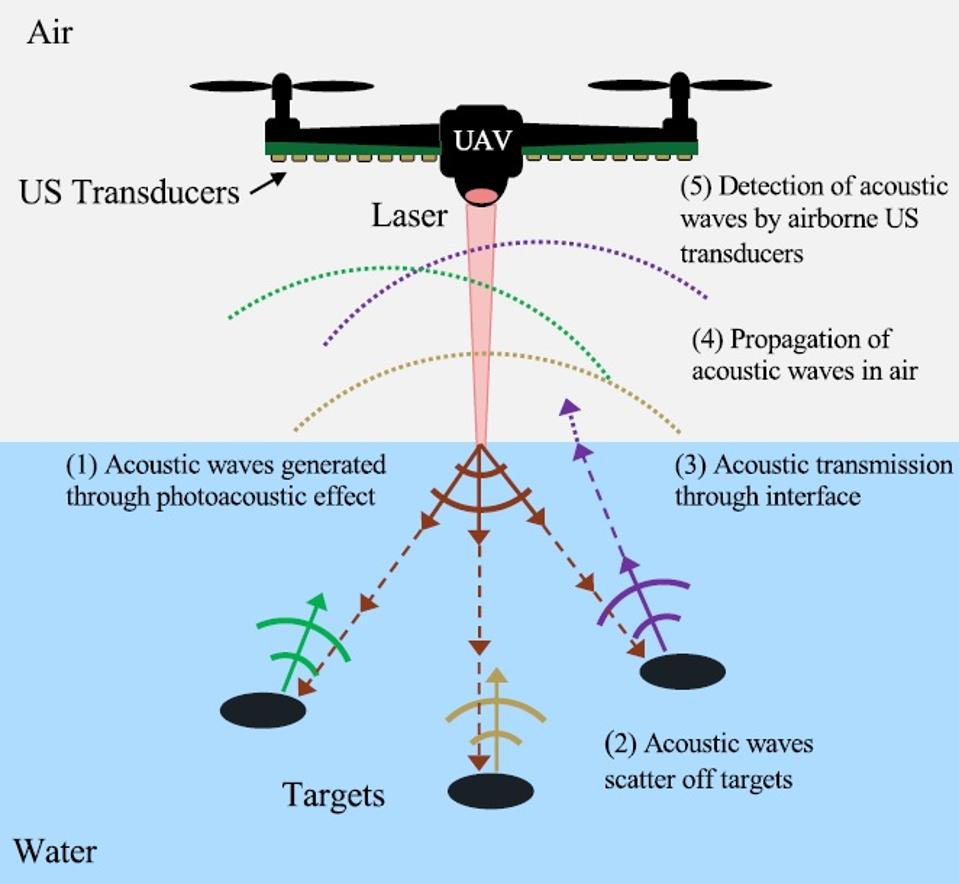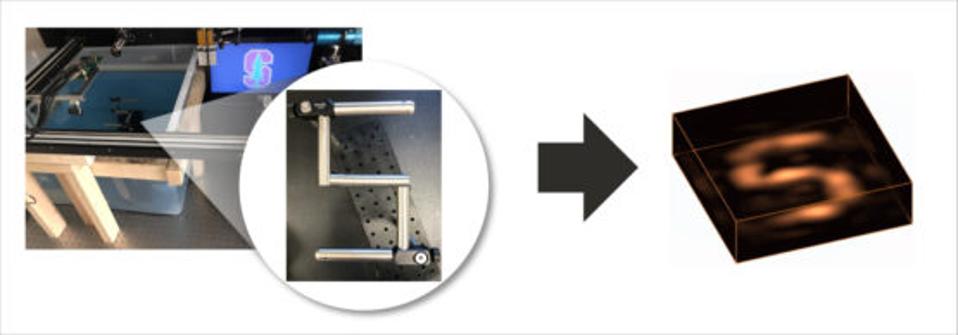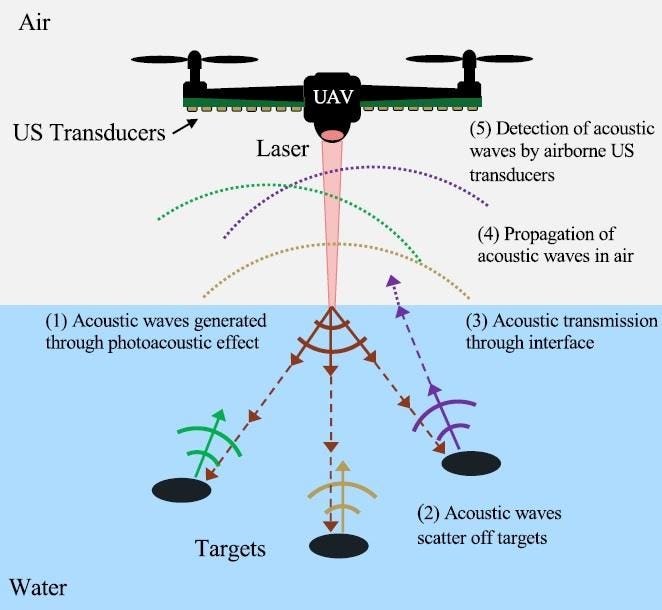Researchers at Stanford University have developed a new type of sonar to overcome the previously insurmountable problem of seeing underwater from the air. Sound does not travel easily between air and water: there is a 65-decibel loss, which means roughly a million-fold decrease in intensity, making it makes it virtually impossible to pick up sound reflections from the air. The new technology can map the seabed and potentially detect mines, submarines and other underwater targets from aircraft.
Currently, the only ways of using sonar from aircraft are sonar buoys (sonobuoys) dropped into the water, or dipping sonar lowered to the sea surface from a hovering helicopter. The helicopter cannot move while using dipping sonar, so it has to check one spot, raising the sonar, fly somewhere else, lowering the sonar again, and so on.
By contrast, the new Photoacoustic Airborne Sonar System or PASS, developed at Stanford with funding from the U.S. Navy, will work from a moving aircraft.
“Our vision of the proposed technology is to capture images continuously as the airborne vehicle flies over the water,” Stanford researcher Aidan Fitzpatrick told Forbes. “Similar to how synthetic aperture radar systems or in-water synthetic aperture sonar systems work today.”
PASS combines two advanced technologies to achieve this feat: laser-generated sound, and novel sound sensors.

A flying drone detects underwater targets using PASS sonar: laser pulses produced sound waves underwater, which are picked up by transducers on the drone
A short laser pulse heats the water surface, causing it to expand rapidly and producing a sound wave. The sound radiates out and reflects back from the seabed or submerged objects, like a conventional sonar source. This eliminates the loss of intensity going from air to water.
PASS needs extremely sensitive sound detection – it still has to cope with the loss of sound in the return from water to air. Most current sound sensors are piezoelectric, based on ceramics which generate an electrical potential when sound hits them. PASS uses different sensors known as capacitive micromachined ultrasonic transducers (CMUTs). These are tiny micro-machined capacitors consisting of two thin parallel plates close to each other. Any disturbance of the plates, such as vibration of a sound wave, changes the electrical properties of the capacitor which can be easily detected.
Fitzpatrick says their CMUTs are vastly more efficient for this role than piezoelectric transducers.
“Since CMUTs are mechanical devices that convert sound waves to electrical signals through vibration of a very thin plate as the sound waves impinge on the plate, they have a very high coupling coefficient – meaning that they are capable of converting a large majority of the incident sound energy to electrical energy,” says Fitzpatrick.
CMUTs are, as it happens, a Stanford invention, developed by professor Butrus Khuri-Yakub in the mid-1990s. They have matured rapidly and are increasingly used by companies like Hitachi and Phillips for medical ultrasound. One advantage of the technology is low cost; mass production means that large and highly sensitive arrays of CMUTs are possible, the equivalent of the AESA arrays in modern aircraft radar.
The team did look at alternative approaches of sound sensing from the air, including laser vibrometry using a laser to detect sound vibrations at the water surface. This turned out to be less effective, and in particular suffered from the difficulty of picking out the signal from the background noise. Because the CMUTs are tuned to resonate at the exact frequency of the laser pulse sound pulse, they receive the signal clearly and efficiently blank out extraneous noise.

In a demonstration, the PASS sensor created an image of an S-shaped underwater target
The prototype PASS is optimized for high-resolution seabed mapping, creating a detailed three-dimensional map. Currently such surveys need to be carried out by ships or unmanned submarines, a slow and laborious process. Surveying from the air could cover much larger areas more rapidly.
The first demonstration of PASS was carried out on a modest scale, with a target in a fishtank-sized container being scanned by a sonar just a few centimeters about the water surface. But the developers see no particular issues with scaling it up at least to the size of a drone flying some tens of meters above the water and viewing objects at depths of hundreds of meters. The PASS sonar could be a low-cost device weighing just a few kilos, making it possible to equip a fleet of sea-skimming drones.
Fitzpatrick notes that if the only requirement for the current system was for detection (rather than imaging), which is what dipping sonar provides, they could use lower acoustic frequencies and operate from much higher altitudes.
The researchers are now working on tests in larger settings, with the aim of being able to demonstrate PASS in an open-water environment. The research is sponsored by the U.S. Office of Naval Research but corporate partnership will be needed to turn the laboratory prototype into a finished product. Given the potential of PASS to transform anti-submarine warfare, that might happen fairly quickly.

 www.forbes.com
www.forbes.com
@Yasar @yakusha @Cabatli_53 @Test7 @Combat-Master @Madokafc @Saithan @anmdt @Zafer @Sinan @bsruzm
Currently, the only ways of using sonar from aircraft are sonar buoys (sonobuoys) dropped into the water, or dipping sonar lowered to the sea surface from a hovering helicopter. The helicopter cannot move while using dipping sonar, so it has to check one spot, raising the sonar, fly somewhere else, lowering the sonar again, and so on.
By contrast, the new Photoacoustic Airborne Sonar System or PASS, developed at Stanford with funding from the U.S. Navy, will work from a moving aircraft.
“Our vision of the proposed technology is to capture images continuously as the airborne vehicle flies over the water,” Stanford researcher Aidan Fitzpatrick told Forbes. “Similar to how synthetic aperture radar systems or in-water synthetic aperture sonar systems work today.”
PASS combines two advanced technologies to achieve this feat: laser-generated sound, and novel sound sensors.

A flying drone detects underwater targets using PASS sonar: laser pulses produced sound waves underwater, which are picked up by transducers on the drone
A short laser pulse heats the water surface, causing it to expand rapidly and producing a sound wave. The sound radiates out and reflects back from the seabed or submerged objects, like a conventional sonar source. This eliminates the loss of intensity going from air to water.
PASS needs extremely sensitive sound detection – it still has to cope with the loss of sound in the return from water to air. Most current sound sensors are piezoelectric, based on ceramics which generate an electrical potential when sound hits them. PASS uses different sensors known as capacitive micromachined ultrasonic transducers (CMUTs). These are tiny micro-machined capacitors consisting of two thin parallel plates close to each other. Any disturbance of the plates, such as vibration of a sound wave, changes the electrical properties of the capacitor which can be easily detected.
Fitzpatrick says their CMUTs are vastly more efficient for this role than piezoelectric transducers.
“Since CMUTs are mechanical devices that convert sound waves to electrical signals through vibration of a very thin plate as the sound waves impinge on the plate, they have a very high coupling coefficient – meaning that they are capable of converting a large majority of the incident sound energy to electrical energy,” says Fitzpatrick.
CMUTs are, as it happens, a Stanford invention, developed by professor Butrus Khuri-Yakub in the mid-1990s. They have matured rapidly and are increasingly used by companies like Hitachi and Phillips for medical ultrasound. One advantage of the technology is low cost; mass production means that large and highly sensitive arrays of CMUTs are possible, the equivalent of the AESA arrays in modern aircraft radar.
The team did look at alternative approaches of sound sensing from the air, including laser vibrometry using a laser to detect sound vibrations at the water surface. This turned out to be less effective, and in particular suffered from the difficulty of picking out the signal from the background noise. Because the CMUTs are tuned to resonate at the exact frequency of the laser pulse sound pulse, they receive the signal clearly and efficiently blank out extraneous noise.

In a demonstration, the PASS sensor created an image of an S-shaped underwater target
The prototype PASS is optimized for high-resolution seabed mapping, creating a detailed three-dimensional map. Currently such surveys need to be carried out by ships or unmanned submarines, a slow and laborious process. Surveying from the air could cover much larger areas more rapidly.
The first demonstration of PASS was carried out on a modest scale, with a target in a fishtank-sized container being scanned by a sonar just a few centimeters about the water surface. But the developers see no particular issues with scaling it up at least to the size of a drone flying some tens of meters above the water and viewing objects at depths of hundreds of meters. The PASS sonar could be a low-cost device weighing just a few kilos, making it possible to equip a fleet of sea-skimming drones.
Fitzpatrick notes that if the only requirement for the current system was for detection (rather than imaging), which is what dipping sonar provides, they could use lower acoustic frequencies and operate from much higher altitudes.
The researchers are now working on tests in larger settings, with the aim of being able to demonstrate PASS in an open-water environment. The research is sponsored by the U.S. Office of Naval Research but corporate partnership will be needed to turn the laboratory prototype into a finished product. Given the potential of PASS to transform anti-submarine warfare, that might happen fairly quickly.

New Sonar Sees Underwater From The Air, Promising To Transform Anti-Submarine Warfare
A new type of sonar developed at Stanford University with funding from the U.S. Navy can see objects underwater from the air. This could transform detection of submarines and underwater mines.
 www.forbes.com
www.forbes.com
@Yasar @yakusha @Cabatli_53 @Test7 @Combat-Master @Madokafc @Saithan @anmdt @Zafer @Sinan @bsruzm

